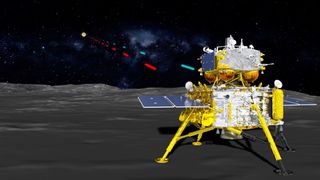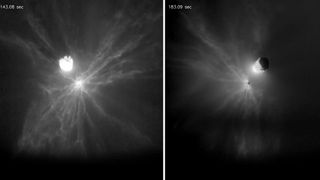Keith Cooper is a freelance science journalist and editor in the United Kingdom, and has a degree in physics and astrophysics from the University of Manchester. He's the author of "The Contact Paradox: Challenging Our Assumptions in the Search for Extraterrestrial Intelligence" (Bloomsbury Sigma, 2020) and has written articles on astronomy, space, physics and astrobiology for a multitude of magazines and websites.
Latest articles by Keith Cooper

Scientists just made the 1st antimatter 'qubit.' Here's why it could be a big deal
By Keith Cooper published
Although the antimatter qubit won't find use in quantum computing, it will be used to test the differences between matter and antimatter.

'The ocean is no longer too big to watch': How AI and satellite data are helping rid Earth's seas of illegal fishing
By Keith Cooper published
Protected regions of the ocean are doing their job and keeping illegal fishing at bay, according to new research combining satellite imagery with artificial intelligence.

SpaceX launches NASA's TRACERS mission to protect Earth from space weather
By Keith Cooper last updated
NASA's TRACERS mission blasted off July 23 on a Falcon 9 rocket with three other small agency satellites that will act as technology demonstrators to monitor space weather.

Sharp-eyed US-Indian satellite set to launch July 30 to monitor Earth's surface, warn of natural disasters
By Keith Cooper published
NISAR, a joint mission of NASA and ISRO set to launch on July 30, will be able to see shifts in the landscape smaller than a centimeter to give warning of potential natural disasters.

2 new NASA satellites will track space weather to help keep us safe from solar storms
By Keith Cooper published
The new TRACERS mission will track magnetic reconnection that drives particles down into Earth's atmosphere when space weather turns bad.

Scientists extracted water and oxygen from moon dust using sunlight. Could it work on the lunar surface?
By Keith Cooper published
Soil excavated from the moon could be used to produce oxygen and methane, which could be used by lunar settlers for breathing and for rocket fuel.

2 billion-year-old moon rock found in Africa reveals secret lunar history
By Keith Cooper published
The basaltic meteorite is a piece of lunar rock that formed in a lava flow 2.35 billion years ago, long after volcanism on the moon was supposed to have ended.

If aliens existed on Mars 3.7 billion years ago, they would have needed umbrellas
By Keith Cooper published
"Our work is a new piece of evidence that suggests that Mars was once a much more complex and active planet than it is now."

Why is the moon's far side so weird? China's lunar sample-return mission may have figured it out
By Keith Cooper published
The impact that carved out the moon's huge South Pole-Aitken basin may explain the puzzling differences between the lunar near and far sides.

Trump's 'Big Beautiful Bill' pushes for crewed moon missions, but proposed budget cuts leave NASA science behind
By Keith Cooper published
The U.S. government's "One, Big Beautiful Bill" Act finds funding for Artemis and Lunar Gateway, but nearly half of NASA's science missions are on the chopping block ahead of the 2026 budget.

'Pebble' beaches around young stars join together to form planets
By Keith Cooper published
Planetary construction sites around other stars are filled with pebbles, and for the first time radio telescopes have detected these tiny chunks of rock that stick together to form planets.

Scientists discover ice in space isn't like water on Earth after all
By Keith Cooper published
Scientists had assumed that the ice in space was purely amorphous, but new experiments show it can have a partly crystalline structure similar to ice on Earth.

NASA's asteroid-crash Earth defense tactic has a complication — DART ejected large boulders into space
By Keith Cooper published
"You can think of it as a cosmic pool game. We might miss the pocket if we don't consider all the variables."

The ocean on Saturn's icy moon Enceladus has the right pH for life — barely
By Keith Cooper published
"We know that some microbes on Earth can tolerate the range of pH found on Enceladus."

How your smartphone is powered by debris from a nova star explosion
By Keith Cooper published
The discovery could explain why younger stars seem to have more lithium than the Big Bang theory says they should have.

NASA teaches Mars orbiter to roll over in quest to find Red Planet water
By Keith Cooper published
The spacecraft now almost tips upside down relative to Mars to give its radar the best view.

US military cuts climate scientists off from vital satellite sea-ice data
By Keith Cooper published
In the latest attack on science by the Trump administration, researchers at the National Snow and Ice Data Center will no longer receive data from a fleet of military satellites.

Biting the 'Bullet': Amazing new JWST photo shows titanic collision of galaxy clusters
By Keith Cooper published
It's another step on the road to one day discovering what dark matter could be.

By locking its greenhouse gas away in rocks, Mars gradually grew cooler and drier
By Keith Cooper published
As the sun grew hotter, so did Mars, prompting much of its atmospheric carbon dioxide to rain out and ultimately get locked up in rocks.

'Like finding a tropical seed in Arctic ice': How a surprise mineral could change the history of asteroid Ryugu
By Keith Cooper published
"Its occurrence is like finding a tropical seed in Arctic ice – indicating either an unexpected local environment or long-distance transport in the early solar system."

Cosmic images from the world's largest digital camera are so big they require a 'data butler'
By Keith Cooper published
The amount of data generated by the Rubin Observatory is going to blow all previous cosmic datasets out of the water, but handling that much information poses a severe challenge.

Moon dust is less toxic than urban air pollution, scientists discover
By Keith Cooper published
Breathing in moon dust can still give you what one astronaut called "lunar hay fever."

50 years later, Apollo 17’s moon samples are still revealing secrets about lunar volcanoes
By Keith Cooper published
The beads are over 3.3 billion years old, and date from the formation of the "Man in the Moon."

Star-forming cloud Chamaeleon I looks like a cosmic masterpiece in new Dark Energy Camera image (video)
By Keith Cooper published
Part of the closest star-forming region to us, known as the Chamaeleon Complex, has been illuminated by the light of young stars in this artwork by nature captured by the Dark Energy Camera.

Pluto's hazy skies are making the dwarf planet even colder, James Webb Space Telescope finds
By Keith Cooper published
Simultaneously cooling Pluto while energizing atmospheric molecules to allow them to escape into space, Pluto's haze plays a key role in the planet's energy balance.
Breaking space news, the latest updates on rocket launches, skywatching events and more!

